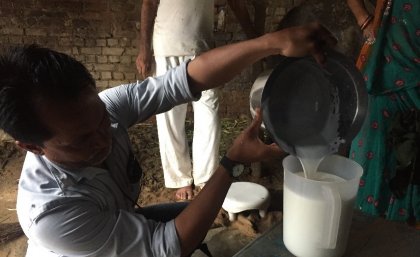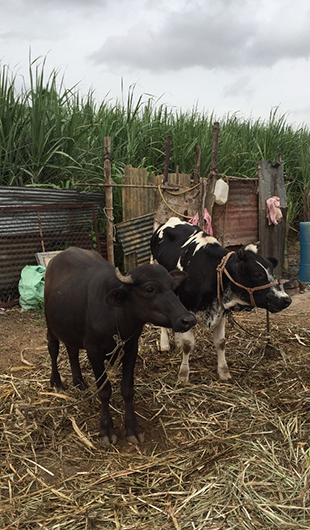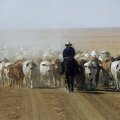
With support from the Bill & Melinda Gates Foundation, University of Queensland researchers are assisting smallholder milk producers in India with AI-based breeding technology.
With more than 1.3 billion people in India, the country’s milk producers are focussed on maintaining supply.
Professor Ben Hayes, who co-developed the big data genomic breeding technology, said India relied on cow and buffalo milk as an important source of nutrients – especially for children.
“Most of Indian’s milk is produced by small holder farmers with as few as two animals,” Professor Hayes said.
Their income from milk is often the difference between ‘getting by’ and poverty.”
The smallholder producers deliver to a sophisticated and integrated supply chain, which includes a massive distribution arm that can reach nearly all Indian households.
The production arm of the system is facing the same crisis that afflicts agricultural systems globally – more milk is needed to keep pace with growing demand.
However this extra milk needs to be supplied from the same amount of land, water, labour and animal feed.
Professor Hayes is familiar with the issue of increasing supply from the same resource base, having previously addressed similar constraints in the Australian dairy industry.
“The solution lies in taking advantage of existing genetic variation between animals in how efficient they are at turning feed into milk,” Professor Hayes said.
“The trick is to establish a breeding program that identifies these animals, and to use them for breeding the herds of the future.”
However achieving this goal in a production system dominated by smallholder farmers introduces its own challenges.
Past breeding efforts in India have seen milk production rates stall at about four to five litres per animal per day.
In the Australian dairy industry, Professor Hayes was able to apply one of the most advanced breeding technologies currently available – a technology he co-developed called ‘genomic selection’ – to make rapid and efficient gains possible.
Genomic selection uses big data bioinformatics derived from genome-wide analysis of performance recorded cows to detect gene effects associated with the desired trait.
 The technology enables modelling to predict the genetic combinations, and therefore the stud bulls, best suited to achieving genetic gain in the breeding target.
The technology enables modelling to predict the genetic combinations, and therefore the stud bulls, best suited to achieving genetic gain in the breeding target.
As a world-leading expert in genomic selection and its application to cattle-based industries, Professor Hayes was recently recruited by the Bill & Melinda Gates Foundation to revisit the stalled genetic gain, and the associated food security and poverty reduction implications, of India’s milk industry.
“With this project we are aiming to double milk production to about 10 litres a day and achieve it with a modest increase in feed,” Professor Hayes said.
The project is being undertaken in collaboration with Indian smallholder farmers who are already logging the milk production rates in order to generate data vital to Professor Hayes’s computing algorithms.
Also taking part are two Indian organisations that are essential to the development of an integrated milk supply chain that seeks to pull smallholder farmers out of poverty.
The first is the BAIF Development Research Foundation, an organisation committed to promoting sustainable livelihoods among the rural poor through climate-resilient agriculture.
The second is the Amul cooperative, which was founded to stop the exploitation of milk producers by middlemen.
Amul-branded milk forms an important cornerstone of the milk supply chain and has a handling capacity of five million litres per day.
The project is also recording fertility traits associated with the genotyped cows and buffalos to ensure, in pushing more energy into milk production, the breeding program doesn’t accidentally reduce fertility.
“From experience we know that if you select really hard for gains in milk production, fertility will decline,” Professor Hayes said.
“We know that from 40 years of industries in other countries moving in the wrong direction.
“We are not going to make that mistake with the Indian cattle, so we are selecting for both milk production and fertility at the same time.”
Media: Professor Ben Hayes, b.hayes@uq.edu.au, +61 7 33462173; Carolyn Martin, QAAFI Communication, carolyn.martin@uq.edu.au, +61 439 399 886.
.jpg)









